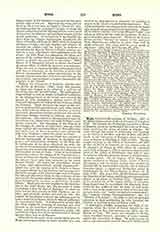

Hugo, CHARLES-HYACINTHE, b. September 20, 1667, at St. Mihiel (Department of Meuse, France); d. August 2, 1739. He entered the Norbertine novitiate at Ponta-Mousson, where he pronounced his vows on August 28, 1685, receiving the name of Louis in religion. He went through his course of philosophy and theology at the Abbey of Jovillier, near Bar-le-Duc, and afterwards at the University of Bourges, where he graduated as Doctor of Theology in 1690 or 1691. Having taught theology in the Abbey of Jandeures, and later in that of Etival in Lorraine, he was named prior of St. Joseph‘s at Nancy in 1700, where he remained until 1713, although in 1708 he had been elected coadjutor of the Abbey of Flabemont, then held in commendam by Nicholas Brisacier, doctor of the Sorbonne, a secular priest. On August 12, 1710, Hugo was chosen coadjutor to Simeon Godin, Abbot of Etival (Stivagium), and the choice having been ratified by Clement XI, he was installed with the title of Abbot of Fontaine-Andre, a suppressed Norbertine abbey in Switzerland, by the Prince-Bishop of Basle, on July 23, 1712. Ten years later Abbot Simeon resigned the direction of the abbey, and Hugo was unanimously elected in his place, October 22, 1722. Though now at the head of one of the largest abbeys in Lorraine, Hugo found time to coordinate the numerous documents he had collected and the notes he had made with a view to the publication of three of his most important works, the “Sacrae antiquitatis monumenta”, the “Annales Ordinis Prmonstratensis”, and the “History of Lorraine“. In order to give his personal attention to their publication, he even favored the erection of printing presses at Etival itself.
A regrettable conflict respecting the right of exemption which the Abbot of Etival claimed for his abbey arose at that time between the abbot and the Bishop of Toul. The cause was brought to Rome, where Cardinal Lercari, secretary of state, warmly upheld the contention of Hugo. In order to put an end to this lamentable incident Benedict XIII named Hugo Bishop of Ptolemais in partibus in the consistory of December 15, 1728.
Hugo had long planned to write a full and detailed history of the Norbertine Order, and in 1717 the general chapter of the order had encouraged him to carry out his plan by naming him historiographer of the order and by requesting all the abbots to give him all the information they possessed concerning their abbeys. The first two volumes of the “Annales” had already been published and the third was in the hands of the royal censor when Hugo died.
That Hugo was a strenuous, learned, and conscientious worker may be judged from the number and the importance of the books he has published or prepared for publication. His style is elegant and harmonious, and, as August Digot says with reference to the “History of Lorraine“, it surpasses that of Dom Calmet, whose style is heavy and diffuse. In 1699 Hugo published a “Refutation of the system of Faydit on the Blessed Trinity“; it was a solid work, according to Paquot. He is also the author of some books on the Order of Canons Regular, one of which is favorably referred to by Benedict XIV; likewise of several dissertations on seals, coins, or medals, on persons and historical matters appertaining to the ducal house of Lorraine. On March 17, 1708, he was made by Duke Leopold a member of his privy council and requested to write the history of Lorraine. Hugo set to work with his usual energy and the work was ready in 1713, but Leopold, fearing that, owing to Hugo’s previous writings, this history might too much displease the royal house of France, asked Dom Cal-met, Abbot of Senones, to write the history instead of Hugo. Hugo’s “Vie de St. Norbert, fondateur des Premontres” (Luxembourg, 1704) is remarkable for the elegance of its style and the important documents it contains. His two monumental works are: (I) “Sacrae antiquitatis monumenta historica, dogmatica, diplomatica, notis illustrata”, in two volumes. The first volume was published in 1725; the second, after Hugo’s death, in 1744; (2) “Sacri et Canonici Ordinis Priemonstratensis Annales”, in two volumes, giving in alphabetical order the history of each abbey. There are two more volumes of probationes, such as charters, etc., respecting each abbey. The third volume, with the title “Annales Ordinis Praemonstratensis Sieculum Primum (1120-1220)”, which was to be followed by four more volumes, was ready for the press when Hugo died. After Hugo’s death the Abbey of Etival was given in commendam to the Bishop of Toul, and for one reason or another the third volume has, unfortunately, never been printed. ‘Hugo’s manuscripts, forming eighteen volumes in folio, each of from 500 to 600 pages, are now preserved in the seminary of Nancy. They are fully described by M. Vacant, professor at the seminary, in “La Bibliotheque du Grand Seminaire de Nancy” (1897).
F. M. GEUDENS

